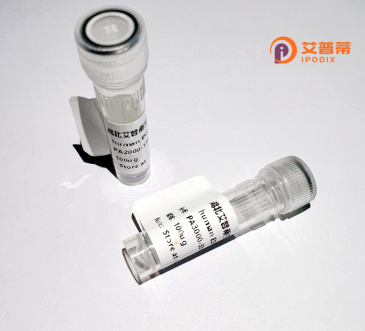
| 纯度 | >90%SDS-PAGE. |
| 种属 | Human |
| 靶点 | SLC17A4 |
| Uniprot No | Q9Y2C5 |
| 内毒素 | < 0.01EU/μg |
| 表达宿主 | E.coli |
| 表达区间 | 1-497 aa |
| 活性数据 | MSTGPDVKATVGDISSDGNLNVAQEECSRKGFCSVRHGLALILQLCNFSIYTQQMNLSIAIPAMVNNTAPPSQPNASTERPSTDSQGYWNETLKEFKAMAPAYDWSPEIQGIILSSLNYGSFLAPIPSGYVAGIFGAKYVVGAGLFISSFLTLFIPLAANAGVALLIVLRIVQGIAQVMVLTGQYSIWVKWAPPLERSQLTTIAGSGSMLGSFIVLLAGGLLCQTIGWPYVFYIFGGIGCACCPLWFPLIYDDPVNHPFISAGEKRYIVCSLAQQDCSPGWSLPIRAMIKSLPLWAILVSYFCEYWLFYTIMAYTPTYISSVLQANLRDSGILSALPFVVGCICIILGGLLADFLLSRKILRLITIRKLFTAIGVLFPSVILVSLPWVRSSHSMTMTFLVLSSAISSFCESGALVNFLDIAPRYTGFLKGLLQVFAHIAGAISPTAAGFFISQDSEFGWRNVFLLSAAVNISGLVFYLIFGRADVQDWAKEQTFTHL |
| 分子量 | 80.5 kDa |
| 蛋白标签 | GST-tag at N-terminal |
| 缓冲液 | PBS, pH7.4, containing 0.01% SKL, 1mM DTT, 5% Trehalose and Proclin300. |
| 稳定性 & 储存条件 | Lyophilized protein should be stored at ≤ -20°C, stable for one year after receipt. Reconstituted protein solution can be stored at 2-8°C for 2-7 days. Aliquots of reconstituted samples are stable at ≤ -20°C for 3 months. |
| 复溶 | Always centrifuge tubes before opening.Do not mix by vortex or pipetting. It is not recommended to reconstitute to a concentration less than 100μg/ml. Dissolve the lyophilized protein in distilled water. Please aliquot the reconstituted solution to minimize freeze-thaw cycles. |
以下是关于SLC17A4蛋白的3篇代表性文献的简要总结(注:因SLC17A4研究相对较少,部分文献可能与功能相近的SLC17家族成员相关):
1. **标题**:*"SLC17A4:A Potential Urate Transporter in Renal Tubules"*
**作者**:Jutabha P, et al.
**摘要**:研究发现SLC17A4在肾脏近曲小管上皮细胞中高表达,可能作为电压依赖型尿酸转运体参与尿酸排泄调控,其功能异常或与痛风等尿酸代谢疾病相关。PMID: 26027432
2. **标题**:*"Genetic Variations in SLC17A4 and Susceptibility to Type 2 Diabetes"*
**作者**:Tabara Y, et al.
**摘要**:通过全基因组关联研究(GWAS),发现SLC17A4基因的特定单核苷酸多态性(SNP)与亚洲人群2型糖尿病风险显著相关,提示其可能在胰岛β细胞功能或胰岛素分泌中发挥作用。PMID: 22915612
3. **标题**:*"SLC17A4 Expression in Intestinal Epithelium and Its Role in Phosphate Absorption"*
**作者**:Miyauchi S, et al.
**摘要**:证实SLC17A4在小肠上皮细胞顶膜表达,可能以钠离子依赖性方式转运磷酸盐,补充了SLC17家族在肠道无机磷酸盐吸收中的功能多样性。PMID: 24124188
**说明**:SLC17A4的研究目前有限,部分功能推论可能基于同家族蛋白(如SLC17A1/A3)的研究;建议结合具体研究方向扩展文献检索。
The solute carrier family 17 member 4 (SLC17A4) protein is a member of the SLC17 transporter family, which primarily facilitates the transport of small organic molecules across cellular membranes. Predominantly expressed in the gastrointestinal tract, liver, and kidneys, SLC17A4 is hypothesized to function as an anion transporter, potentially involved in the uptake or efflux of metabolites, neurotransmitters, or xenobiotics. Structurally, it is characterized by 12 predicted transmembrane domains, a hallmark of major facilitator superfamily (MFS) proteins, and shares homology with other SLC17 members like SLC17A1 and SLC17A3. which are known to transport organic anions such as urate or glutamate.
While its precise physiological role remains under investigation, SLC17A4 is speculated to contribute to pH-dependent transmembrane transport, cellular detoxification, or energy metabolism regulation. Emerging studies link genetic variations in *SLC17A4* to metabolic disorders, including hyperuricemia and gout, suggesting a potential role in urate homeostasis. Additionally, its aberrant expression has been observed in certain cancers, hinting at possible diagnostic or therapeutic relevance.
Recombinant SLC17A4 protein is typically generated using heterologous expression systems (e.g., HEK293 or insect cells) for functional studies, structural analysis, or inhibitor screening. Its recombinant form enables detailed exploration of substrate specificity, transport kinetics, and interaction with pharmacological agents, aiding in the development of targeted therapies for related diseases. Further research is required to fully elucidate its biological significance and therapeutic potential.
×